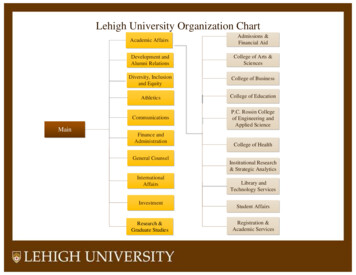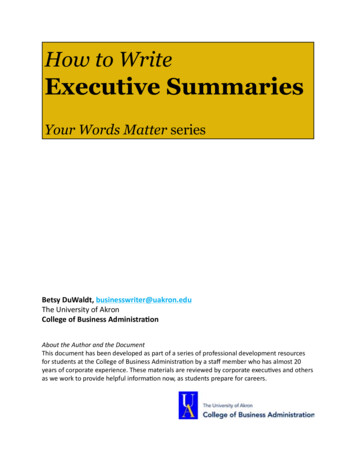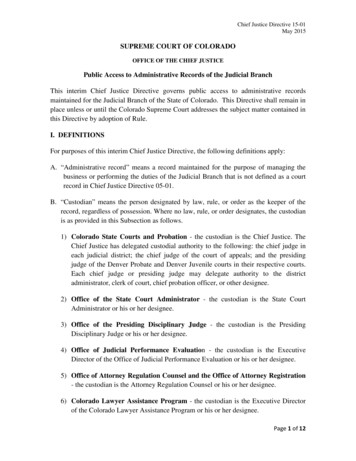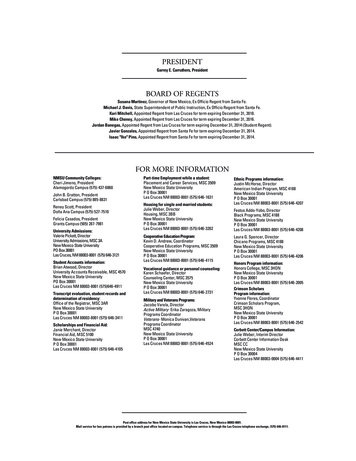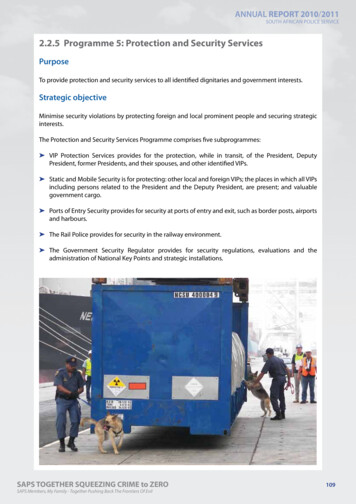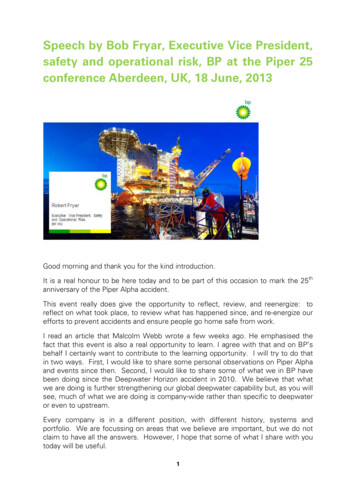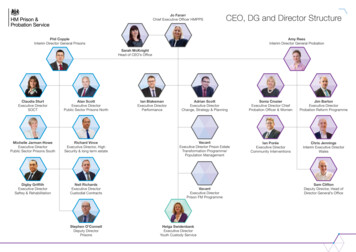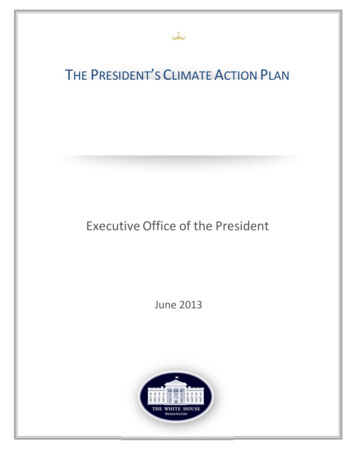
Transcription
THE PRESIDENT’S CLIMATE ACTION PLANExecutive Office of the PresidentJune 2013
Table of ContentsCUT CARBON POLLUTION IN AMERICA . 6I.Deploying Clean Energy . 6Cutting Carbon Pollution from Power Plants . 6Promoting American Leadership in Renewable Energy. 6II.III.IV.Unlocking Long‐Term Investment in Clean Energy Innovation . 7Building a 21st‐Century Transportation Sector . 8Increasing Fuel Economy Standards . 8Developing and Deploying Advanced Transportation Technologies . 8Cutting Energy Waste in Homes, Businesses, and Factories . 9Reducing Energy Bills for American Families and Businesses . 9Reducing Other Greenhouse Gas Emissions . 10Curbing Emissions of Hydrofluorocarbons . 10Reducing Methane Emissions . 10V.Preserving the Role of Forests in Mitigating Climate Change . 11Leading at the Federal Level . 11Leading in Clean Energy. 11PREPARE THE UNITED STATES FOR THE IMPACTS OF CLIMATE CHANGE . 12 I.Building Stronger and Safer Communities and Infrastructure . 12Directing Agencies to Support Climate‐Resilient Investment . 12Establishing a State, Local, and Tribal Leaders Task Force on Climate Preparedness . 13Supporting Communities as they Prepare for Climate Impacts . 13Boosting the Resilience of Buildings and Infrastructure. 13II.Rebuilding and Learning from Hurricane Sandy . 13Protecting our Economy and Natural Resources . 14Identifying Vulnerabilities of Key Sectors to Climate Change . 14Promoting Resilience in the Health Sector . 14Promoting Insurance Leadership for Climate Safety . 14Conserving Land and Water Resources . 15Maintaining Agricultural Sustainability . 15Managing Drought . 15Reducing Wildfire Risks . 15III.Preparing for Future Floods . 15Using Sound Science to Manage Climate Impacts . 162
Developing Actionable Climate Science . 16Assessing Climate‐Change Impacts in the United States . 16Launching a Climate Data Initiative . 16Providing a Toolkit for Climate Resilience:. 16LEAD INTERNATIONAL EFFORTS TO ADDRESS GLOBAL CLIMATE CHANGE. 17I.Working with Other Countries to Take Action to Address Climate Change . 17Enhancing Multilateral Engagement with Major Economies . 17Expanding Bilateral Cooperation with Major Emerging Economies . 17Combatting Short‐Lived Climate Pollutants . 17Reducing Emissions from Deforestation and Forest Degradation . 18Expanding Clean Energy Use and Cut Energy Waste . 18Negotiating Global Free Trade in Environmental Goods and Services . 19Phasing Out Subsidies that Encourage Wasteful Consumption of Fossil Fuels . 20Leading Global Sector Public Financing Towards Cleaner Energy . 20Strengthening Global Resilience to Climate Change . 20II.Mobilizing Climate Finance . 20Leading Efforts to Address Climate Change through International Negotiations . 213
PRESIDENT OBAMA’S CLIMATE ACTION PLAN“We, the people, still believe that our obligations as Americans are not just to ourselves, but toall posterity. We will respond to the threat of climate change, knowing that the failure to do sowould betray our children and future generations. Some may still deny the overwhelmingjudgment of science, but none can avoid the devastating impact of raging fires and cripplingdrought and more powerful storms.The path towards sustainable energy sources will be long and sometimes difficult. But Americacannot resist this transition, we must lead it. We cannot cede to other nations the technology thatwill power new jobs and new industries, we must claim its promise. That’s how we will maintainour economic vitality and our national treasure -- our forests and waterways, our croplands andsnow-capped peaks. That is how we will preserve our planet, commanded to our care by God.That’s what will lend meaning to the creed our fathers once declared.”-- President Obama, Second Inaugural Address, January 2013THE CASE FOR ACTIONWhile no single step can reverse the effects of climate change, we have a moral obligation tofuture generations to leave them a planet that is not polluted and damaged. Through steady,responsible action to cut carbon pollution, we can protect our children’s health and begin to slowthe effects of climate change so that we leave behind a cleaner, more stable environment.In 2009, President Obama made a pledge that by 2020, America would reduce its greenhouse gasemissions in the range of 17 percent below 2005 levels if all other major economies agreed tolimit their emissions as well. Today, the President remains firmly committed to that goal and tobuilding on the progress of his first term to help put us and the world on a sustainable long-termtrajectory. Thanks in part to the Administration’s success in doubling America’s use of wind,solar, and geothermal energy and in establishing the toughest fuel economy standards in ourhistory, we are creating new jobs, building new industries, and reducing dangerous carbonpollution which contributes to climate change. In fact, last year, carbon emissions from theenergy sector fell to the lowest level in two decades. At the same time, while there is more workto do, we are more energy secure than at any time in recent history. In 2012, America’s net oilimports fell to the lowest level in 20 years and we have become the world’s leading producer ofnatural gas – the cleanest-burning fossil fuel.While this progress is encouraging, climate change is no longer a distant threat – we are alreadyfeeling its impacts across the country and the world. Last year was the warmest year ever in thecontiguous United States and about one-third of all Americans experienced 10 days or more of100-degree heat. The 12 hottest years on record have all come in the last 15 years. Asthma rateshave doubled in the past 30 years and our children will suffer more asthma attacks as airpollution gets worse. And increasing floods, heat waves, and droughts have put farmers out ofbusiness, which is already raising food prices dramatically.These changes come with far-reaching consequences and real economic costs. Last year alone,there were 11 different weather and climate disaster events with estimated losses exceeding 1billion each across the United States. Taken together, these 11 events resulted in over 110billion in estimated damages, which would make it the second-costliest year on record.4
In short, America stands at a critical juncture. Today, President Obama is putting forward abroad-based plan to cut the carbon pollution that causes climate change and affects public health.Cutting carbon pollution will help spark business innovation to modernize our power plants,resulting in cleaner forms of American-made energy that will create good jobs and cut ourdependence on foreign oil. Combined with the Administration’s other actions to increase theefficiency of our cars and household appliances, the President’s plan will reduce the amount ofenergy consumed by American families, cutting down on their gas and utility bills. The plan,which consists of a wide variety of executive actions, has three key pillars:1) Cut Carbon Pollution in America: In 2012, U.S. carbon emissions fell to the lowest levelin two decades even as the economy continued to grow. To build on this progress, the ObamaAdministration is putting in place tough new rules to cut carbon pollution – just like we havefor other toxins like mercury and arsenic – so we protect the health of our children and moveour economy toward American-made clean energy sources that will create good jobs andlower home energy bills.2) Prepare the United States for the Impacts of Climate Change: Even as we take new stepsto reduce carbon pollution, we must also prepare for the impacts of a changing climate thatare already being felt across the country. Moving forward, the Obama Administration willhelp state and local governments strengthen our roads, bridges, and shorelines so we canbetter protect people’s homes, businesses and way of life from severe weather.3) Lead International Efforts to Combat Global Climate Change and Prepare for itsImpacts: Just as no country is immune from the impacts of climate change, no country canmeet this challenge alone. That is why it is imperative for the United States to couple actionat home with leadership internationally. America must help forge a truly global solution tothis global challenge by galvanizing international action to significantly reduce emissions(particularly among the major emitting countries), prepare for climate impacts, and driveprogress through the international negotiations.Climate change represents one of our greatest challenges of our time, but it is a challengeuniquely suited to America’s strengths. Our scientists will design new fuels, and our farmers willgrow them. Our engineers to devise new sources of energy, our workers will build them, and ourbusinesses will sell them. All of us will need to do our part. If we embrace this challenge, we willnot just create new jobs and new industries and keep America on the cutting edge; we will savelives, protect and preserve our treasured natural resources, cities, and coastlines for futuregenerations.What follows is a blueprint for steady, responsible national and international action to slow theeffects of climate change so we leave a cleaner, more stable environment for future generations.It highlights progress already set in motion by the Obama Administration to advance these goalsand sets forth new steps to achieve them.5
CUT CARBON POLLUTION IN AMERICAIn 2009, President Obama made a commitment to reduce U.S. greenhouse gas emissions in therange of 17 percent below 2005 levels by 2020. The President remains firmly committed toachieving that goal. While there is more work to do, the Obama Administration has already madesignificant progress by doubling generation of electricity from wind, solar, and geothermal, andby establishing historic new fuel economy standards. Building on these achievements, thisdocument outlines additional steps the Administration will take – in partnership with states, localcommunities, and the private sector – to continue on a path to meeting the President’s 2020goal.I.Deploying Clean EnergyCutting Carbon Pollution from Power Plants: Power plants are the largest concentrated sourceof emissions in the United States, together accounting for roughly one-third of all domesticgreenhouse gas emissions. We have already set limits for arsenic, mercury, and lead, but there isno federal rule to prevent power plants from releasing as much carbon pollution as they want.Many states, local governments, and companies have taken steps to move to cleaner electricitysources. More than 35 states have renewable energy targets in place, and more than 25 have setenergy efficiency targets.Despite this progress at the state level, there are no federal standards in place to reduce carbonpollution from power plants. In April 2012, as part of a continued effort to modernize our electricpower sector, the Obama Administration proposed a carbon pollution standard for new powerplants. The Environmental Protection Agency’s proposal reflects and reinforces the ongoingtrend towards cleaner technologies, with natural gas increasing its share of electricity generationin recent years, principally through market forces and renewables deployment growing rapidly toaccount for roughly half of new generation capacity installed in 2012.With abundant clean energy solutions available, and building on the leadership of states andlocal governments, we can make continued progress in reducing power plant pollution toimprove public health and the environment while supplying the reliable, affordable powerneeded for economic growth. By doing so, we will continue to drive American leadership inclean energy technologies, such as efficient natural gas, nuclear, renewables, and clean coaltechnology.To accomplish these goals, President Obama is issuing a Presidential Memorandum directing theEnvironmental Protection Agency to work expeditiously to complete carbon pollution standardsfor both new and existing power plants. This work will build on the successful first-term effort todevelop greenhouse gas and fuel economy standards for cars and trucks. In developing thestandards, the President has asked the Environmental Protection Agency to build on stateleadership, provide flexibility, and take advantage of a wide range of energy sources andtechnologies including many actions in this plan.Promoting American Leadership in Renewable Energy: During the President’s first term, theUnited States more than doubled generation of electricity from wind, solar, and geothermalsources. To ensure America’s continued leadership position in clean energy, President Obamahas set a goal to double renewable electricity generation once again by 2020. In order to meet6
this ambitious target, the Administration is announcing a number of new efforts in the followingkey areas: Accelerating Clean Energy Permitting: In 2012 the President set a goal to issue permitsfor 10 gigawatts of renewables on public lands by the end of the year. The Department ofthe Interior achieved this goal ahead of schedule and the President has directed it topermit an additional 10 gigawatts by 2020. Since 2009, the Department of Interior hasapproved 25 utility-scale solar facilities, nine wind farms, and 11 geothermal plants,which will provide enough electricity to power 4.4 million homes and support anestimated 17,000 jobs. The Administration is also taking steps to encourage thedevelopment of hydroelectric power at existing dams. To develop and demonstrateimproved permitting procedures for such projects, the Administration will designate theRed Rock Hydroelectric Plant on the Des Moines River in Iowa to participate in itsInfrastructure Permitting Dashboard for high-priority projects. Also, the Department ofDefense – the single largest consumer of energy in the United States – is committed todeploying 3 gigawatts of renewable energy on military installations, including solar,wind, biomass, and geothermal, by 2025. In addition, federal agencies are setting a newgoal of reaching 100 megawatts of installed renewable capacity across the federallysubsidized housing stock by 2020. This effort will include conducting a survey of currentprojects in order to track progress and facilitate the sharing of best practices. Expanding and Modernizing the Electric Grid: Upgrading the country’s electric gridis critical to our efforts to make electricity more reliable, save consumers money on theirenergy bills, and promote clean energy sources. To advance these important goals,President Obama signed a Presidential Memorandum this month that directs federalagencies to streamline the siting, permitting and review process for transmission projectsacross federal, state, and tribal governments.Unlocking Long-Term Investment in Clean Energy Innovation: The Fiscal Year 2014Budget continues the President’s commitment to keeping the United States at the forefront ofclean energy research, development, and deployment by increasing funding for clean energytechnology across all agencies by 30 percent, to approximately 7.9 billion. This includesinvestment in a range of energy technologies, from advanced biofuels and emerging nucleartechnologies – including small modular reactors – to clean coal. To continue America’sleadership in clean energy innovation, the Administration will also take the following steps: Spurring Investment in Advanced Fossil Energy Projects: In the coming weeks, theDepartment of Energy will issue a Federal Register Notice announcing a draft of asolicitation that would make up to 8 billion in (self-pay) loan guarantee authority availablefor a wide array of advanced fossil energy projects under its Section 1703 loan guaranteeprogram. This solicitation is designed to support investments in innovative technologies thatcan cost-effectively meet financial and policy goals, including the avoidance, reduction, orsequestration of anthropogenic emissions of greenhouse gases. The proposed solicitation willcover a broad range of advanced fossil energy projects. Reflecting the Department’scommitment to continuous improvement in program management, it will take comment onthe draft solicitation, with a plan to issue a final solicitation by the fall of 2013. Instituting a Federal Quadrennial Energy Review: Innovation and new sources ofdomestic energy supply are transforming the nation’s energy marketplace, creating economic7
opportunities at the same time they raise environmental challenges. To ensure that federalenergy policy meets our economic, environmental, and security goals in this changinglandscape, the Administration will conduct a Quadrennial Energy Review which will be ledby the White House Domestic Policy Council and Office of Science and Technology Policy,supported by a Secretariat established at the Department of Energy, and involving the robustengagement of federal agencies and outside stakeholders. This first-ever review will focus oninfrastructure challenges, and will identify the threats, risks, and opportunities for U.S.energy and climate security, enabling the federal government to translate policy goals into aset of analytically based, clearly articulated, sequenced and integrated actions, and proposedinvestments over a four-year planning horizon.II.Building a 21st-Century Transportation SectorIncreasing Fuel Economy Standards: Heavy-duty vehicles are currently the second largestsource of greenhouse gas emissions within the transportation sector. In 2011, the ObamaAdministration finalized the first-ever fuel economy standards for Model Year 2014-2018 forheavy-duty trucks, buses, and vans. These standards will reduce greenhouse gas emissions byapproximately 270 million metric tons and save 530 million barrels of oil. During the President’ssecond term, the Administration will once again partner with industry leaders and other keystakeholders to develop post-2018 fuel economy standards for heavy-duty vehicles to furtherreduce fuel consumption through the application of advanced cost-effective technologies andcontinue efforts to improve the efficiency of moving goods across the United States.The Obama Administration has already established the toughest fuel economy standards forpassenger vehicles in U.S. history. These standards require an average performance equivalent of54.5 miles per gallon by 2025, which will save the average driver more than 8,000 in fuel costsover the lifetime of the vehicle and eliminate six billion metric tons of carbon pollution – morethan the United States emits in an entire year.Developing and Deploying Advanced Transportation Technologies: Biofuels have animportant role to play in increasing our energy security, fostering rural economic development,and reducing greenhouse gas emissions from the transportation sector. That is why theAdministration supports the Renewable Fuels Standard, and is investing in research anddevelopment to help bring next-generation biofuels on line. For example, the United States Navyand Departments of Energy and Agriculture are working with the private sector to accelerate thedevelopment of cost-competitive advanced biofuels for use by the military and commercialsectors. More broadly, the Administration will continue to leverage partnerships between theprivate and public sectors to deploy cleaner fuels, including advanced batteries and fuel celltechnologies, in every transportation mode. The Department of Energy’s eGallon informs driversabout electric car operating costs in their state – the national average is only 1.14 per gallon ofgasoline equivalent, showing the promise for consumer pocketbooks of electric-poweredvehicles. In addition, in the coming months, the Department of Transportation will work withother agencies to further explore strategies for integrating alternative fuel vessels into the U.S.flag fleet. Further, the Administration will continue to work with states, cities and towns throughthe Department of Transportation, the Department of Housing and Urban Development, and theEnvironmental Protection Agency to improve transportation options, and lower transportationcosts while protecting the environment in communities nationwide.8
III.Cutting Energy Waste in Homes, Businesses, and FactoriesReducing Energy Bills for American Families and Businesses: Energy efficiency is one of theclearest and most cost-effective opportunities to save families money, make our businesses morecompetitive, and reduce greenhouse gas emissions. In the President’s first term, the Departmentof Energy and the Department of Housing and Urban Development completed efficiencyupgrades in more than one million homes, saving many families more than 400 on their heatingand cooling bills in the first year alone. The Administration will take a range of new steps gearedtowards achieving President Obama’s goal of doubling energy productivity by 2030 relative to2010 levels: Establishing a New Goal for Energy Efficiency Standards: In President Obama’s firstterm, the Department of Energy established new minimum efficiency standards fordishwashers, refrigerators, and many other products. Through 2030, these standards willcut consumers’ electricity bills by hundreds of billions of dollars and save enoughelectricity to power more than 85 million homes for two years. To build on this success,the Administration is setting a new goal: Efficiency standards for appliances and federalbuildings set in the first and second terms combined will reduce carbon pollution by atleast 3 billion metric tons cumulatively by 2030 – equivalent to nearly one-half of thecarbon pollution from the entire U.S. energy sector for one year – while continuing to cutfamilies’ energy bills. Reducing Barriers to Investment in Energy Efficiency: Energy efficiency upgradesbring significant cost savings, but upfront costs act as a barrier to more widespreadinvestment. In response, the Administration is committing to a number of new executiveactions. As soon as this fall, the Department of Agriculture’s Rural Utilities Service willfinalize a proposed update to its Energy Efficiency and Conservation Loan Program toprovide up to 250 million for rural utilities to finance efficiency investments bybusinesses and homeowners across rural America. The Department is also streamliningits Rural Energy for America program to provide grants and loan guarantees directly toagricultural producers and rural small businesses for energy efficiency and renewableenergy systems.In addition, the Department of Housing and Urban Development’s efforts include a 23million Multifamily Energy Innovation Fund designed to enable affordable housingproviders, technology firms, academic institutions, and philanthropic organizations to testnew approaches to deliver cost-effective residential energy. In order to advance ongoingefforts and bring stakeholders together, the Federal Housing Administration will convenerepresentatives of the lending community and other key stakeholders for a mortgageroundtable in July to identify options for factoring energy efficiency into the mortgageunderwriting and appraisal process upon sale or refinancing of new or existing homes. Expanding the President’s Better Buildings Challenge: The Better BuildingsChallenge, focused on helping American commercial and industrial buildings become atleast 20 percent more energy efficient by 2020, is already showing results. More than 120diverse organizations, representing over 2 billion square feet are on track to meet the2020 goal: cutting energy use by an average 2.5 percent annually, equivalent to about 58million in energy savings per year. To continue this success, the Administration willexpand the program to multifamily housing – partnering both with private and affordable9
building owners and public housing agencies to cut energy waste. In addition, theAdministration is launching the Better Buildings Accelerators, a new track that willsupport and encourage adoption of State and local policies to cut energy waste, buildingon the momentum of ongoing efforts at that level.IV.Reducing Other Greenhouse Gas EmissionsCurbing Emissions of Hydrofluorocarbons: Hydrofluorocarbons (HFCs), which are primarilyused for refrigeration and air conditioning, are potent greenhouse gases. In the United States,emissions of HFCs are expected to nearly triple by 2030, and double from current levels of 1.5percent of greenhouse gas emissions to 3 percent by 2020.To reduce emissions of HFCs, the United States can and will lead both through internationaldiplomacy as well as domestic actions. In fact, the Administration has already acted by includinga flexible and powerful incentive in the fuel economy and carbon pollution standards for cars andtrucks to encourage automakers to reduce HFC leakage and transition away from the most potentHFCs in vehicle air conditioning systems. Moving forward, the Environmental ProtectionAgency will use its authority through the Significant New Alternatives Policy Program toencourage private sector investment in low-emissions technology by identifying and approvingclimate-friendly chemicals while prohibiting certain uses of the most harmful chemicalalternatives. In addition, the President has directed his Administration to purchase cleaneralternatives to HFCs whenever feasible and transition over time to equipment that uses safer andmore sustainable alternatives.Reducing Methane Emissions: Curbing emissions of methane is critical to our overall effort toaddress global climate change. Methane currently accounts for roughly 9 percent of domesticgreenhouse gas emissions and has a global warming potential that is more than 20 times greaterthan carbon dioxide. Notably, since 1990, methane emissions in the United States have decreasedby 8 percent. This has occurred in part through partnerships with industry, both at home andabroad, in which we have demonstrated that we have the technology to deliver emissionsreductions that benefit both our economy and the environment. To achieve additional progress,the Administration will: Developing an Interagency Methane Strategy: The Environmental Pr
progress through the international negotiations. Climate change represents one of our greatest challenges of our time, but it is a challenge uniquely suited to America’s strengths. Our scientists will design new fuels, and our farmers will grow them. Our engineers to devise new
